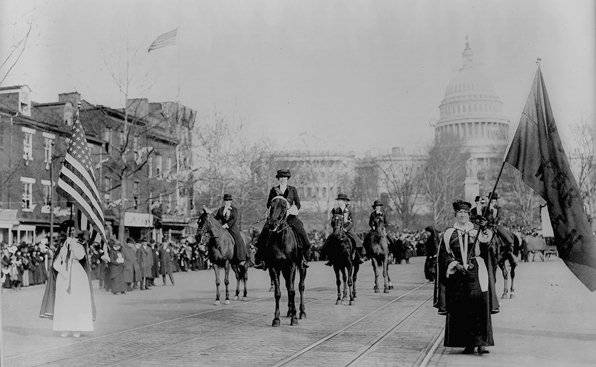
This image was captured in 1913 during a women’s suffrage march in Washington D.C.
This procession was attacked by angry onlookers while police stood by. The march occurred the day before Woodrow Wilson’s inauguration. Many of the 5,000 women participating were spat upon and struck in the face as a near riot ensued. Secretary of War Henry Stimson then ordered soldiers from Fort Myer to restore order.
This was the first suffragist parade in Washington, D.C. It was also the first large, organized march on Washington for political purposes. The procession was organized by the suffragists Alice Paul and Lucy Burns for the National American Woman Suffrage Association (NAWSA). Planning for the event began in Washington in December 1912.
The parade’s purpose, stated in its official program, was to “march in a spirit of protest against the present political organization of society, from which women are excluded.”
Suffragists and supporters marched down Pennsylvania Avenue on Monday, March 3, 1913. Paul had selected the venue and date to maximize publicity, but met resistance from the D.C. police department. The demonstration consisted of a procession with floats, bands, and various groups representing women at home, in school, and in the workplace. At the Treasury Building, a pageant of allegorical tableaux was acted out during the parade. The final act was a rally at the Memorial Continental Hall with prominent speakers, including Anna Howard Shaw and Helen Keller.
During the procession, district police failed to keep the enormous crowd off the street, impeding the marchers’ progress. Many participants were subjected to heckling from spectators, though there were also many supporters present. The marchers were finally assisted by citizens’ groups and eventually the cavalry. The police were subjected to a congressional inquiry due to security failures. The event premiered Paul’s campaign to refocus the suffrage movement on obtaining a national constitutional amendment for woman’s suffrage. Intended to pressure President Wilson to support an amendment, he resisted their demands for years afterward.
This procession was attacked by angry onlookers while police stood by. The march occurred the day before Woodrow Wilson’s inauguration. Many of the 5,000 women participating were spat upon and struck in the face as a near riot ensued. Secretary of War Henry Stimson then ordered soldiers from Fort Myer to restore order.
This was the first suffragist parade in Washington, D.C. It was also the first large, organized march on Washington for political purposes. The procession was organized by the suffragists Alice Paul and Lucy Burns for the National American Woman Suffrage Association (NAWSA). Planning for the event began in Washington in December 1912.
The parade’s purpose, stated in its official program, was to “march in a spirit of protest against the present political organization of society, from which women are excluded.”
Suffragists and supporters marched down Pennsylvania Avenue on Monday, March 3, 1913. Paul had selected the venue and date to maximize publicity, but met resistance from the D.C. police department. The demonstration consisted of a procession with floats, bands, and various groups representing women at home, in school, and in the workplace. At the Treasury Building, a pageant of allegorical tableaux was acted out during the parade. The final act was a rally at the Memorial Continental Hall with prominent speakers, including Anna Howard Shaw and Helen Keller.
During the procession, district police failed to keep the enormous crowd off the street, impeding the marchers’ progress. Many participants were subjected to heckling from spectators, though there were also many supporters present. The marchers were finally assisted by citizens’ groups and eventually the cavalry. The police were subjected to a congressional inquiry due to security failures. The event premiered Paul’s campaign to refocus the suffrage movement on obtaining a national constitutional amendment for woman’s suffrage. Intended to pressure President Wilson to support an amendment, he resisted their demands for years afterward.

